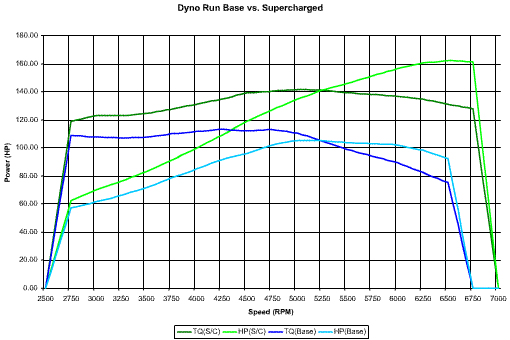Physics Behind Modern 4 Stroke Engines
David Giessel
University of Alaska Fairbanks
Physics 211 Web Project, Fall 2002
David Giessel
University of Alaska Fairbanks
Physics 211 Web Project, Fall 2002
| Index | Engine Basics | Horsepower vs Torque | More Power via Boost | Bibliography | |
Engine output is measured in two ways. The first is a direct measurement of engine output: Torque. Torque is defined as the amount of mass that can be lifted a certain distance from the center of rotation (measured in LB-FT in America and N-M in the rest of the world). Torque is what accelerates a car. It is what pushes you back into your seat when accelerating.
The second way output is measured is in Horsepower (horsepower is assigned the unit PS in other countries). Output is also measured in Kilowatts in the rest of the world. Horsepower is a calculated unit (it is not measured directly). It can simply be thought of as the amount of torque an engine produces at a given RPM. It was originally defined by James Watt as the amount of weight a horse could lift 100 feet in one minute. Watt measured this number to be 330 lbs.
To convert between horsepower and torque we must understand the work and power equations listed below.
Work = Force * 2 * Pi * radians = (in english units) 1 lb * 2 * 3.14 * 1 ft = 2 * 3.14 lb-ft = 6.283 lb-ft
Power = Work / time = 6.283 lb-ft / min
1 hp is defined as 550 lb-ft / s = 33,000 lb-ft / min (from James Watt's measurements)
So, if 1 lb-ft of torque is applied in one minute (1 rpm) = (6.283 lb-ft / min) / (33,000 lb-ft / min) = 1 / 5252 of 1 hp.
From this we can see that there are 5252 lb/ft of torque per minute in one Horsepower. Or...if we multiply torque in lb-ft by the RPM this torque is produced at, then divide by 5252, we get the power output at that RPM. If we look at a engine dyno readout this relationship becomes more clear.

Dyno charts courtesy of SCDYNE performance
ĘThe dark blue and dark green lines are base torque and supercharged torque (we will discuss supercharging on the next page) for a Saturn twin cam engine as measured from the wheels (about 10 percent lower than measured torque at the crank due to friction in the transmission). As you can see the torque curves are very flat up until about 6500 RPM where they start to drop. You can also see clearly how torque increases with RPM linearly as long as the torque curve is flat. If you ride in a car with a flat torque curve you will feel the same push into the back of your seat throughout each gear up into the high RPMs where torque drops off. Horsepower (especially peak horsepower) does not reflect this accelerating push. It simply shows the length of time this torque can be sustained (horsepower climbs until torque drops off). So horsepower is really just a reflection of how long you can accelerate hard in a given gear. Also note that horsepower and torque cross at 5252 RPMs on both dyno charts. This is a result of the previously mentioned relationship between the two.
Engine torque and horsepower do not directly correspond to the car's performance however. For example, a car that makes a lot of torque in the low RPM range but not much power due to a low maximum RPM can be geared with a taller ratio to allow greater speed in a given gear at a given RPM. Conversely a car that does not make much torque but has a very high maximum RPM can be geared low to allow better acceleration. This is why lower power cars such as older Subarus or Toyotas with 90 or less horsepower can be very drivable. Said cars make most of their torque (about 100 lb-ft) in the 2000-3000 RPM range. So the manufacturers equipped them with taller gearing allowing the driver to shift at lower RPMs when accelerating where there is plentiful torque. Many modern cars such as Hondas have the opposite philosophy. These cars make very little torque at low RPMs but can rev very high allowing higher peak power output. These cars have lower gears and are shifted at higher RPMs at the same respective speeds.
With a basic understanding of horsepower and torque, let's look at some ways to generate more of both with boost!